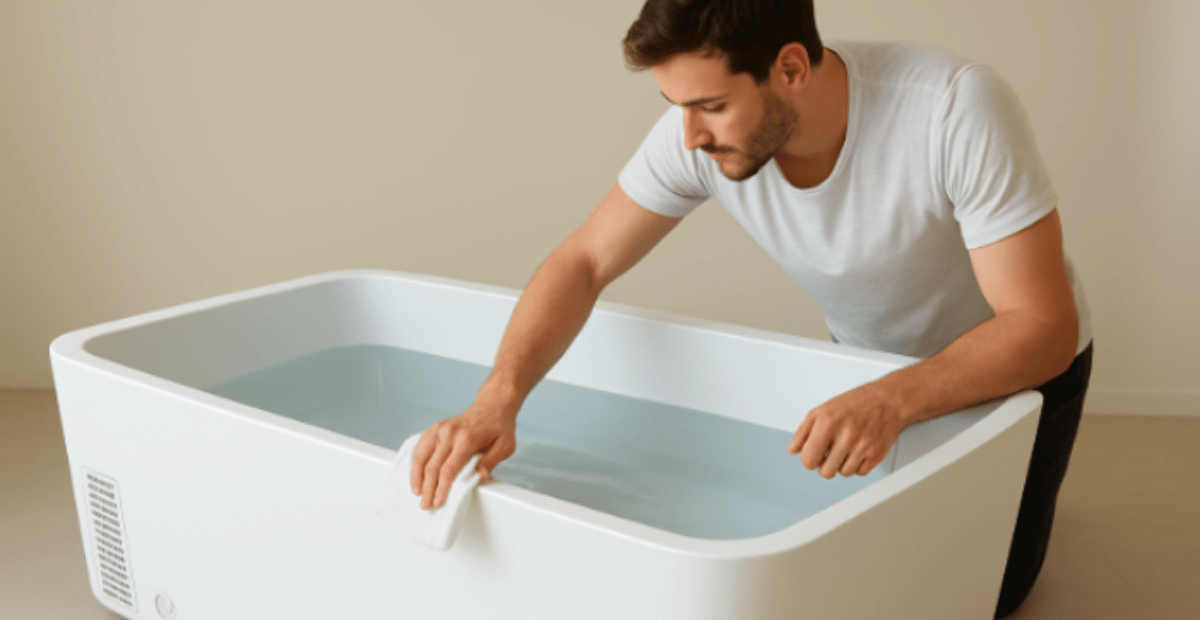Knowing how to keep cold plunge water clean is essential for maintaining both safety and enjoyment in your wellness practice. Properly maintained water not only reduces the risk of bacteria and unpleasant odors but also preserves the refreshing, therapeutic benefits that make cold plunges a rewarding and restorative habit.
In the following sections, we’ll explore practical methods, recommended cleaning schedules, and tools that can simplify cold plunge upkeep. By the end, you’ll have clear strategies for keeping your plunge fresh, safe, and ready for daily use. Continue reading to uncover these insights and helpful tips.
Why Clean Water Matters for Cold Plunge Health and Safety
A cold plunge is often seen as a reset for the mind and body, but without proper care, the water can quickly become a breeding ground for bacteria, mold, or algae. Clean water not only enhances the wellness benefits of immersion but also helps prevent irritation, infection, and unpleasant odors. To simplify maintenance, many users turn to cold therapy ice machines, which support consistent cooling and circulation for cleaner, fresher plunges.
From a health perspective, water quality is directly tied to user safety. Skin conditions such as eczema or acne may worsen with contaminated water, while individuals with weakened immune systems or chronic illnesses may be at greater risk of complications. This is why how to keep cold plunge water clean is not just about appearance, it’s also about ensuring safe use for everyone.
Common Problems with Dirty Cold Plunge Water
Even with good intentions, issues can develop if the water isn’t maintained regularly. Some of the most common concerns include:
-
Algae growth that makes the water look green or slimy
-
Bad odors caused by bacteria or stagnant water
-
Cloudiness from oils, dirt, and debris
-
Skin irritation risks from impurities that build up over time
Addressing these problems promptly can extend the life of your plunge and make every session more enjoyable.
Related article: Best Cold Therapy Ice Machine for Shoulder Surgery Pain Relief
How to Keep Cold Plunge Water Clean: Practical Steps

Keeping your cold plunge fresh and safe doesn’t need to be complicated. Consistency is key.
-
Drain and refill on schedule: Changing your plunge water every one to two weeks, depending on how often you use it, prevents bacteria buildup and keeps the experience safe, refreshing, and sanitary.
-
Use filters and pumps: Installing a filter and pump system ensures water constantly circulates, trapping dirt, hair, and other particles. This simple setup helps maintain clarity and reduces the frequency of full water changes.
-
Water treatments: Instead of relying on harsh pool chemicals, gentle options like ozone purifiers or UV sanitation systems can keep your water clean, fresh, and safe without irritating your skin or eyes.
-
Skim debris and cover: Regularly skimming floating debris and using a snug, fitted cover minimizes contamination from leaves, oils, and dust, keeping your plunge water cleaner, clearer, and more inviting between sessions.
Developing a routine ensures you always know how to keep this device clean without letting small issues turn into bigger problems.
Cold Plunge You May Want to Shop
Explore MoreBest Natural and Chemical Options for Water Treatment
For those who prefer a natural approach, treatments like hydrogen peroxide or salt-based systems can help keep water clear without heavy chemicals. Bromine is another option, often gentler on skin compared to chlorine.
Chemical treatments, when used correctly, can also be effective, but it’s important to handle them with care and follow dosage guidelines. Individuals with sensitive skin or chronic medical conditions should consult a healthcare professional before introducing new treatments to ensure safety.
Maintenance Tools and Accessories Worth Considering
The right tools can make all the difference when learning how to keep cold plunge water clean. Some essentials include:
-
Water test strips to monitor pH and sanitation levels
-
Manual skimmers for removing surface debris
-
Cleaning brushes for scrubbing walls and floors
-
Insulated covers to minimize contamination and maintain temperature
-
Replacement filters for those using plunge tubs with pumps
These tools simplify the process, reduce maintenance time, and ensure your plunge always feels inviting.
Related article: Best Cold Therapy Machine for Knee Recovery and Comfort
How Often Should You Change Cold Plunge Water?
The frequency depends on how often you use your plunge and how many people share it. For solo users with proper filtration, water might stay fresh for up to two weeks. Heavier use, especially with outdoor plunges, may require weekly changes. Some find that full body cold therapy machines help extend freshness and cooling efficiency, making maintenance more manageable.
Alongside full refills, schedule quick cleanings (skimming and testing) every few days and deeper scrubs once a month. By developing this balance, you’ll master how to keep cold plunge water clean in both the short and long term.
Product Spotlight: Airvida Cold Plunge

For those who want a low-maintenance and durable option, the Airvida Cold Plunge offers a modern solution. Its insulated design helps preserve water quality and temperature, meaning fewer refills and less daily upkeep. The sturdy materials also resist wear, making it an excellent choice for home and professional use.
Key advantages include:
-
Insulated design that maintains water quality and temperature longer
-
Durable build resistant to wear and tear
-
Reduced need for frequent refills and cleaning
-
Suitable for both personal and professional wellness settings
What sets this plunge apart is its convenience. It’s designed with longevity in mind, giving users peace of mind when focusing on recovery and relaxation. For anyone exploring how to keep this device clean with minimal effort, investing in a high-quality product like this can make all the difference.
Tips for Long-Term Cold Plunge Care
Beyond weekly and monthly maintenance, long-term care ensures your plunge stays in excellent condition year after year. Consider these practices:
-
Perform seasonal deep cleanings with safe scrubbing agents
-
Drain and store plunge tubs properly if not in use for extended periods
-
Keep the plunge area free from dirt, leaves, or moisture buildup to prevent mold.
When combined with regular routines, these steps make it easier to maintain a healthy and refreshing setup. Many enthusiasts also explore cryo cold therapy machines, which can enhance cooling efficiency while supporting cleaner, more consistent plunge experiences at home or in professional wellness spaces.
Conclusion: Keeping Your Cold Plunge Safe and Refreshing
Cold plunges offer refreshing opportunities for wellness and recovery, but the true benefits depend on the cleanliness of the water. Consistent maintenance, regular cleaning, and the right tools help keep the water safe, hygienic, and inviting, ensuring each plunge remains both beneficial and enjoyable for the long term.
Remember, while tips on how to keep cold plunge water clean can support a safer and more enjoyable routine, it’s essential to approach cold immersion thoughtfully. Individuals with medical conditions or health concerns should always consult a qualified healthcare professional before making cold plunges a consistent part of their wellness practice.
FAQs
What can I put in my ice bath to keep the water clean?
You can add natural sanitizers such as hydrogen peroxide, bromine, or salt-based systems to help keep water fresh. These options, when used correctly, may reduce bacteria and algae growth, supporting safe immersion and extending cleanliness between full water changes.
How to keep cold plunge water clean without a filter?
If you don’t have a filter, consistency is key. Regularly skimming debris, covering the plunge when not in use, and using gentle water treatments can help. Draining and refilling on schedule also ensures you know how to keep cold plunge water clean effectively.
How to keep a cold plunge from getting slimy?
Slimy buildup often signals algae or bacteria growth. To prevent it, maintain proper water circulation, clean tub walls weekly, and use a fitted cover. Gentle sanitizing agents like ozone or bromine can also help reduce biofilm and keep the plunge safe.
How often should you change the water in a cold plunge?
Most people benefit from changing the water every 1–2 weeks, depending on use. Outdoor plunges or those with multiple users may require more frequent refills. Testing water quality regularly helps determine the best schedule for safety and freshness.
How to keep cold plunge water cleaner longer?
To extend freshness, always rinse before plunging, use an insulated cover, and skim the surface after each use. Adding safe water treatments and keeping the surrounding area clean also supports how to keep cold plunge water clean for longer periods.
You May Also Want to Read
Importance of Hyperbaric Chamber Training for Medical Staff
7 Powerful Sauna Blanket Benefits for Your Body and Mind
Surprising Hydrogen Inhalation Therapy Benefits You Need to Know





